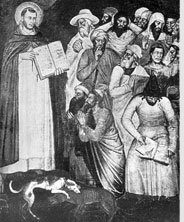Reasons for Chalcedonian Orthodoxy
1. What’s the difference between the view (Nestorianism) that Jesus was two people—one fully human and one fully divine—and the official catholic view above? Both hold that there are two natures and two wills. What’s the difference?
[Trent Dougherty] I think the hinge issue is unity of agency. It’s a *person* who acts, who accrues moral status (being praiseworthy, being a moral example, being the King, etc.). It was important that there was one person who was the Messiah not two people. For example, in the Crucifixion the Nestorian view is that the human person died and the divine person did not. If so, why venerate the divine person and to what avail did the human person die.

(St. Dominic preaching to the heretics)
2. Why is it so important that Jesus be fully human? Why does it have to be a human who saves us from our sins?
[Trent Dougherty] There is a strong tradition from the patristic period and flowering in the Medieval period that the uniting of the human nature to the divine nature conferred a great honor on all humans. It’s hard to make out exactly what the view was but it was a common one. A very imperfect analogy would be the pride I take in being at Rochester in virtue of the fact that Peter van Inwagen went here and Keith Lehrer taught here. Now that got precious little to do with my present circumstances, but it is an undeniable fact that it makes me feel special.
This might have become important in light of the fact that by far the biggest intellectual battle the Church has ever fought—from antiquity to present—is against various forms of Gnosticism. In affirming that the divine second person of the Trinity actually became fully united to a human nature in the Incarnation the Church was utterly rejecting Gnosticism and affirming the redeemability and dignity of the physical as a matter of the utmost doctrine. Clearly Nestorius’ theology was much more amenable to Gnostics and it’s also hard to see how it wouldn’t slide into the Gnostic-like heresy of Arianism. It was in part a pastoral decision.

4 Comments:
Thanks for the post. It's an important and pressing topic.
There's another aspect of the human/divine debate that doesn't get much air play. The Trinitarians tend to focus on the carnal aspects of Jesus. There is a subsidiary worship of Mary and Joseph, the carnal parents of Jesus. This reflects the "carnal mindedness" that Paul alluded to.
Gnostics focus on the spiritual aspects of Christ, rather than the carnal aspects of Jesus. The Christ figure is eternal. It shows up in pre-Christian literature. There are Christ figures in the middle ages who were attacked by the Church for not worshipping Jesus. There are Christ figures today who are attacked by fundamentalists as being wolves in sheep's clothing.
We've said it before, and we'll say it again. Christ is an eternal form, he returned again and again. The Church kept burning him at the stake.
Catholics don't worship Joseph and and Mary, we merely look to them as examples of saying "Yes" to God. We also say "Yes" to the beauty and goodness of God's physical creation.
It's true that in the 2000 year history of the Church there have been some in it who have wrongly persecuted some people, but it is usually blown out of proportion by secular historians and then spread for public consumption. However, this has little evidential bearing on the truth-claims of the Church.
Gnosticism has always existed alongside Christianity because it sounds so similar but is so much easier to believe and live. It doesn't ask much of a person and the theology is quite vague. In the end, I'm Catholic because it's the continuation of the movement that Jesus started. However, being a member of the Church requires much obedience and sacrifice. In the end, though, even this is a source of special blessing that is wanting in systems where you can think and do basically whatever you want without moral or evidential constraints.
I don't know where you got the idea that secular historians have blown religious persecution out of proportion. Even theological historians have commented on the excesses of the Church. For example, Catholic persecution of Jews and the blood libel against Jews exists in the works of Catholic writers.
To say that they have been exaggerated by secular historians is not to deny that they existed.
John Paul the Great has led the Church into a new penitence by acknowledging and apologizing for the sins of Catholics. The beauty of the Catholic Faith is that the call to repentance and the offer of forgiveness is never rescinded.
"The Church is a hospital for sinners, not a museum of the sinless." (adapted from Abigail van Buren)
Post a Comment
<< Home